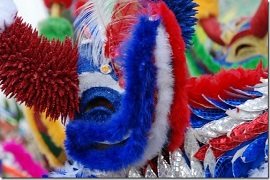In the country, the festivities date back to the year 1500, in the ruins of a city called La Vega. Carnival began almost three centuries ago, before Dominican independence in 1844. Prior to gaining its independence, the Dominican Republic suffered an unstable history under Spanish, French and Haitian occupation.
Christopher Columbus arrived to the island of Hispaniola. today known as the Dominican Republic and Haiti, during his first voyage to the Americas in 1492. The capital of the Dominican Republic, Santo Domingo, was the first Spanish settlement in the New World.
In the 16th century, Hispaniola was the bridge between the Caribbean and continental America under Spanish rule. With the importance of the island on the decline in the 17th century, there came a point when the Spaniards had no choice but to hand over the western part of the island, today known as Haiti, to the French in 1697 and the rest a century later in 1795. The whole island became known as Santo Domingo. The Dominican part did not adapt well to this change of culture and soon after the Haitian part of the island gained its independence in 1804, France lost the rest of the island for good in 1809.
In 1821, the Dominicans achieved independence and expressed hope of joining the Republic of Colombia (Gran Colombia – which today would almost comprise Ecuador, Panama, Venezuela and Colombia). However, in 1822, Haiti conquered the whole island, governing it for 22 woeful years.
During the Haitian occupation, Juan Pablo Duarte, from Santo Domingo, created a secret society called "La Trinitaria" (The Trinity) and planned a coup d'état against the Haitian rulers. On February 27, 1844, Juan Pablo Duarte and the rest of "La Trinitaria" achieved the independence of the Dominican Republic as a sovereign state with a cannon shot from the "Puerta del Conde" (The Count's Gate) in Santo Domingo and hoisted the blue, red and white flag of the Dominican Republic.
Nowadays, on Dominican Independence Day, the locals honor their founding fathers, Juan Pablo Duarte, Ramón Matías Mella and Francisco del Rosario Sánchez in the "Puerta del Conde" in Santo Domingo, where the declaration of the War of Independence was made on February 27, 1844. The president of the Dominican Republic also gives an annual speech on this day to pay homage to them.
Carnival is celebrated every weekend in February, with the parades taking place on Sundays. La Vega attracts people from across the world with one of the biggest parades after that of Santo Domingo. Most cities send representatives to La Vega on Independence Day to march in the parade, dressed in a wide variety of costumes from all over the country.
Carnival in the Dominican Republic is an event prepared and participated in by everyone. Most Dominican cities celebrate the festival with slight differences within their own traditions. These are reflected in the different types of extravagant costumes and masks which represent many religious and traditional figures. Each city organizes groups that wear the same colors or a similar costume to symbolize a character who represents their particular town. The best known characters are the Diablo Cojuelo, Calife and Roba la Gallina. The Diablo Cojuelo is the most common popular figure throughout Carnival. He wears a very striking costume and some suggest he symbolizes the first colonists of the Americas.
The interesting history of the independence of the Dominican Republic is intertwined with its extraordinary February Carnival, an experience that everyone should enjoy at least once in their life.

